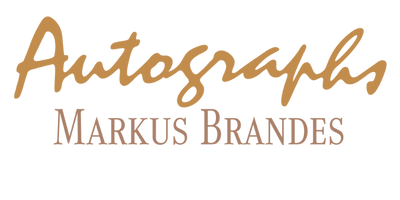A dubious signature clarifies the often discussed question
Real or double? A deception is uncovered | Part 2
Read more: Part 1 by Markus Brandes | Part 2 by Marguerite Spycher |
Further signature references
Marguerite Spycher
Signatures can please, impress, wow - or be collected by interested parties. Sometimes people try to imitate another person's signature. Often there is an intention to forge, with which someone wants to gain an advantage.
Very well-known persons sometimes also have a "double", a person who is very similar to them and who appears in a representative function, if it concerns a less important occasion or if special safety precautions make this appear advisable.
This could also be the case with an appearance by Vladimir Putin, where the otherwise emphatically reserved Kremlin ruler took a dip in the crowd on the occasion of a trade fair in Moscow and drew a caricature on a whiteboard, which he signed with his signature. About it the autograph specialist Markus Brandes has written the 1st part of this small series.
The special thing about signatures
Signatures are legally valid signatures that we use frequently in everyday life. They are legally valid because they are regarded as a unique, very individual expression of personality. They should be unmistakable, precisely so that unauthorized persons cannot gain an advantage by imitating them. Signatures usually become less precise in the course of time. They are often hastily thrown down, the forms then become simpler, connected to each other in a special way, and the whole thing becomes increasingly less legible. At the same time, the movements become highly automated, which means that imitation becomes even more difficult. This is the trail we will follow.
It must be clear in advance: Reliable conclusions about a person can never be drawn from a signature alone; it always requires comparison with text writing.
The investigation material
For the investigation, Markus Brandes provided a considerable number of signatures from the period between 2002 and 2021. They are electronically stored, with few exceptions high resolution and thus absolutely useful for a simple comparison.
For this article, I have selected a securely authentic signature and will explain the personal characteristics of the Kremlin leader's signature based on it.
Real signatures of Vladimir Putin
We have all experienced that our signature is not always exactly the same. The surface, paper quality, writing tool, as well as our state of mind or the specific circumstances, all have a certain influence. Some variation is natural because external factors may play a role, but the essential elements remain. Are you thinking about the forms? Of course, they are recognizable at first glance. The actual substance in a handwriting, if you will, lies in the pressure and, above all, the flow of the writing movement.
In the following, I will illustrate the most important characteristics of Vladimir Putin's signature using an example from the year 2009. The observations apply to all signatures provided, although further illustrations are omitted here.

Fig. 1 Signed karate book 16. 6. 2009 (Source: Markus Brandes Autographs).
The characteristics in keywords: sweeping writing, round movements, imaginary line rising. The beginning skillfully designed, the back part of the signature is written in one stroke and runs in arcade-like loops, which tend to be pointed at the bottom and become increasingly smaller.
Let us consider the details of this signature:

At the beginning, the writing instrument is placed lightly and moved in an imaginary 1; the end shows how the movement is continued. |
Sweeping design of the initial, resembling the Latin B. The arcs tend to be angular in shape. The movement leads to the next character without interruption. |
|
Energetically follows a second circular movement, again with a tendency to corners above. Clear change of direction after smear, acute angle, then again sweeping to the right. |
For the continuation, the Cyrillic u, which resembles the Latin y, is restarted. The rest is continued in one sweeping stroke. The loops become shorter, with a tendency to spikes at the bottom. |
 For the continuation, the Cyrillic "у," which resembles the Latin "y," is reset. The loop extends far downward and tends toward a pointed shape.
|

|
Were you able to follow these explanations? - As you can see, this signature is not that easy! A double is a real pain in the neck, because shapes and movements have to be recognized, practiced, and then implemented with panache.
Is this signature genuine?
This signature is under discussion, the creation of which is documented with video, which has been explained in the article by Markus Brandes.

Fig. 2 Signature from the video
After the above explanations, nevertheless, many deviations are to be recognized.
The striking aspect is the clumsy and incomplete design of the initial letter. Essential parts are missing, and the circular movements were not executed. An open loop to the right hangs detached above the Cyrillic "W" resembling the Latin "B."
Next are two individually placed vertical strokes whose function is as unclear as the mentioned loop. Presumably, this is meant to represent the initial "P" of the last name, but the circular movement and the sweeping concluding movement extending far to the left are missing.
The rest is written in one stroke, albeit with distinct angles and completely without loops.
Result
Based on the apparent inconsistencies in the forms and movement of this signature, it can be concluded with certainty that it was not written by the Kremlin leader. This means that the person who presented themselves as Vladimir Putin at that event in Moscow was a double.
About the author
Marguerite Spycher is a qualified graphologist and has been working as an independent consultant near Zurich for 35 years. She is frequently asked to clarify special questions concerning handwriting. She writes essays on the writings of famous personalities and is the author of the book "One Pope Too Many".
https://grapho.ch and https://margs.ch




